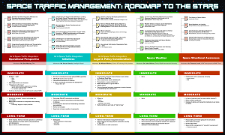Presentation Type
Paper (supporting PowerPoints may be added as Additional Files)
Location
Henderson Welcome Center
Start Date
17-11-2016 10:30 AM
Abstract
The growth in launch and reentry operations in the National Airspace System (NAS) presents the Federal Aviation Administration (FAA) with the challenge of integrating them more efficiently while also minimizing effects on other NAS users and maintaining safety. Currently, to maintain safety and account for unforeseen events such as vehicle breakup, the FAA segregates large amounts of airspace, called Aircraft Hazard Areas (AHAs), from traditional NAS users during launch and reentry operations. In order to minimize effects on NAS users, some AHAs during reentry are dynamically activated only if an unexpected event occurs. If a dynamic AHA is activated, then aircraft would have to evacuate from the AHA before debris reaches the NAS. The FAA can determine how long it takes for debris to reach the NAS (60,000 feet and below), but it does not have a capability to statistically examine how long it would take aircraft to evacuate these AHAs while considering different aircraft performance parameters, airspace traffic patterns, and controllers with different response times. The FAA could also implement smaller AHAs for launches by using dynamic AHAs, but only if they can better understand the time needed to evacuate them. The MITRE Corporation’s Center for Advanced Aviation System Development (MITRE CAASD) is developing a flexible, fast-time modeling and simulation capability that examines the time to evacuate these AHAs and quantifies how different factors (e.g., air traffic control notification delay, traffic orientation, and traffic density) affect those times. This paper describes this modeling capability and demonstrates potential use cases.
Area of Interest
NAS Integration
Biographies
Included in
Aviation and Space Education Commons, Systems Engineering Commons, Systems Engineering and Multidisciplinary Design Optimization Commons

Examining Time to Evacuate Dynamically Activated Aircraft Hazard Areas
Henderson Welcome Center
The growth in launch and reentry operations in the National Airspace System (NAS) presents the Federal Aviation Administration (FAA) with the challenge of integrating them more efficiently while also minimizing effects on other NAS users and maintaining safety. Currently, to maintain safety and account for unforeseen events such as vehicle breakup, the FAA segregates large amounts of airspace, called Aircraft Hazard Areas (AHAs), from traditional NAS users during launch and reentry operations. In order to minimize effects on NAS users, some AHAs during reentry are dynamically activated only if an unexpected event occurs. If a dynamic AHA is activated, then aircraft would have to evacuate from the AHA before debris reaches the NAS. The FAA can determine how long it takes for debris to reach the NAS (60,000 feet and below), but it does not have a capability to statistically examine how long it would take aircraft to evacuate these AHAs while considering different aircraft performance parameters, airspace traffic patterns, and controllers with different response times. The FAA could also implement smaller AHAs for launches by using dynamic AHAs, but only if they can better understand the time needed to evacuate them. The MITRE Corporation’s Center for Advanced Aviation System Development (MITRE CAASD) is developing a flexible, fast-time modeling and simulation capability that examines the time to evacuate these AHAs and quantifies how different factors (e.g., air traffic control notification delay, traffic orientation, and traffic density) affect those times. This paper describes this modeling capability and demonstrates potential use cases.


Comments
Visit the Research Panel: Through the NAS